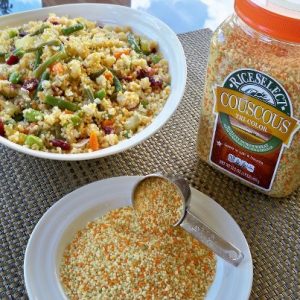Couscous is a wonderful traditional Middle Eastern grain made from semolina that is versatile and tasty not to mention easy to cook. It is my go to choice for so many applications that I had to share a few ideas about cooking couscous with everyone. I am using the pre-steamed semolina couscous that you find in most grocery stores not the pearl/Israeli style or the traditional kind you may be able to find in Middle Eastern markets that needs longer cooking times. I have used this versatile ingredient as a hot or cold side dish, a salad, a stuffing and as a main course. It is an inexpensive pantry item that you can use to give past their prime veggies and leftovers new life. Let’s start with the basics and then we will move from there.
Couscous, like pasta, is a blank canvas that you can flavor with your favorite ingredients. This is what makes it such a useful pantry item, its quick, tasty, and adaptable. It is also very sturdy, it can be served hot, cold or anywhere in between, it’s not going to spoil on the way to a picnic or in a school lunch. It can sit on a buffet table or hang in the fridge until you are ready to use it. It reheats, it travels and it pairs nicely with everything from lamb to fresh tomatoes.
Cooking Couscous on the Stove
Cooking couscous could not be simpler, add a small amount of fat (oil or butter) to some liquid (wine, broth or water) in a pot bring to a boil and drop in the couscous, remove from the heat, cover and wait about 5 minutes then fluff with a fork and enjoy. The couscous water ratio is normally one to one but check instructions for the brand you have purchased it can vary.
Cooking Couscous in the Microwave
Put as much water as you need in a microwave safe bowl and bring to a boil in the microwave. Remove from the microwave and pour over the dry couscous, mix. Cover the couscous with a lid or plate and let sit for about 10 minutes. Then fluff the cooked couscous with a fork. The correct couscous water ratio is normally 1 to 1 check instructions for the brand you have purchased it can vary.
Cooking couscous in the microwave is great if you plan on mixing in leftover veggies or other items that also just need a quick reheat before they are added to your dish.
How to Make Couscous Tasty

This is dry couscous, this brand uses spinach and tomato to color the pasta. Couscous is a pantry staple that I always have on hand.
Now let’s talk about fixing it up so it tastes awesome. Most of the couscous you will buy in the store will tell you to cook it in water and may have a small spice packet to mix into the cooking water. The spice packets are mostly salt and some sad dry herbs, you can use it…I guess. I buy the large containers of couscous that don’t have the flavor packets or anything added to it they are cheaper. Also this way I can choose what to add and have total control of the end product. I cook my couscous in what I have on hand, canned or homemade chicken broth, white wine or vegetarian bouillon if I am feeding my yoga studio; sometimes I will even blend any or all of the preceding together. The wine I find is best if the couscous is going to be served hot or used to stuff pork or poultry, for most other applications I opt for the chicken broth or a mix of the two (good way to use up leftovers and make couscous tasty).
The veggies and other extras you are going to add I have divided into three groups: needs to be precooked, needs a little heat, or needs just to be mixed in. The items that need to be precooked go into your pot with a drizzle of olive oil and are sautéed until al dente. Then you add the broth/wine bring to a boil and add the couscous with the items that need a little heat, cover and let everything rest in the hot pot for five to ten minutes. When you open the pot to fluff and put the couscous in a serving dish add the last group of extras that just need to be mixed in. If you are making a cold couscous salad you may have to wait for the couscous cool before this last group of extras are added, especially if it’s something like fresh tomatoes or delicate herbs.
When I am going to make couscous I start by looking in the fridge, freezer and pantry to see what I have that might taste good together. This is your chance to use up your leftovers liked cooked veggies and meats or those last bits of cheese. I don’t have recipe, this is a dish concocted out of opportunities.
Guidelines for Cooking Couscous
There are a few basic guidelines that will help you as you get comfortable with making the most out of cooking couscous. Dice all your ingredients into small pieces so that someone eating your couscous can eat bites that included multiple extras in a forkful. You will need to add lots of flavor, this means don’t be scared to add salt, pepper, garlic and any other herbs or spices you like. This is a good place play with contrasts like salty and sweet or soft and crunchy, so experiment with ingredients that are in opposition. Lastly don’t feel like you must put anything special in your couscous, whatever you have on hand will be perfect, my lists of ideas are just that ideas, go crazy!!
These lists are far from complete and I can’t say you should add all these things to any one pot of couscous these are just ideas. I pull from this bank of ideas and try to build a theme: Italian, Greek, Indian, or whatever. Just have fun!!
Needs to be pre cooked
- Celery
- Onion
- Garlic
- Carrots
- Mushrooms
- Broccoli Rabe
- Shallots
Needs a little heat
- Leftover cooked veggies that are cold from the fridge
- Leftover cooked meats (chicken, lamb, you name it)
- Canned Beans: white, red, chick peas, or black (drain and rinse first)
- Frozen veggies: peas, corn, soy beans, pearl onions (if you are serving hot couscous)
- Firm veggies you want to soften (cauliflower, broccoli, green beans, asparagus, bell peppers)
- Dry fruit that you want to plump and soften, like raisins or apricots
Needs to be mixed into hot couscous before serving
- Leafy greens like spinach or kale that you want to wilt
- Dry fruit that does not need much heat to plump, like dry cranberries or dates and figs
- Nuts: pine nuts, pecans, walnuts, hazelnuts or almond slivers
- Sturdy fresh herbs like parsley or basil
- Green onions and chive
- Lemon juice or zest
- Olives and other pickled veggies like okra or giardiniera
- Frozen veggies that you want to help chill a cold salad type of couscous (peas, soy beans, corn)
- Canned veggies rinsed and drained (corn, bamboo shoots, water chestnuts)
- Already warm or room temperature proteins like shrimp, chicken or even tofu
- Leftover cooked veggies that aren’t cold or can’t take too much heat
- Cheese (feta, Parmesan, blue)
Needs to be mixed into cool/cold couscous
- Leafy greens that you don’t want to wilt like frisee lettuce or arugula
- Fresh tomatoes
- Fresh peas
- Delicate herbs like thyme
- Lemon juice and zest
- Fresh fruit: grapes, citrus, figs
- Cold proteins that you don’t want to heat at all, like perfectly cooked shrimp
- Cheese (feta, Parmesan, blue, mozzarella)
- Bean sprouts
- High quality flavored olive oils that can’t stand up to heat well
- Vinaigrette salad dressing
So now that you have a few ideas what you can toss into your cooked couscous I am going to give you a few examples of what I have made in the past that has been well received by my family. I am not going to give you any measurement for quantities because I normally am using up what I have so the ratios will vary every batch. Always adjust the salt, pepper and lemon juice/vinegar to taste.
Cooking Couscous with Vegetables and More
Basic I-need-a-side-dish-ASAP couscous (I serve this hot, cold or in between)
Precooked: celery, onion, carrot and garlic
A little heat: frozen peas or soy beans, dried cranberries
Add at the end: fresh basil or parsley and juice of a lemon
Greek flavored (serve at room temp)
Precooked: celery, onion and shallots
A little heat: thin sliced red onion, Greek olives
Add at the end: fresh mint, lemon juice, cucumber, feta cheese
Italian flavored (serve at room temp or chill and swap bocconcini mozzarella for the parm)
Precooked: onion and lots of garlic
A little heat: last night’s asparagus, handful of spinach
Add at the end: sliced cherry tomatoes, fresh basil, white balsamic vinegar, parmesan
Middle Eastern (serve with lamb or any rich meat dish)
Precooked: onion, celery, carrot and pinch each of coriander and cumin
A little heat: pre roasted yellow or acorn squash cubes, golden raisins, dry apricots
Add at the end: parsley, toasted pine nuts, orange zest, and a drizzle of good olive oil
The basic recipe I have used mostly as a side dish and then sent leftovers as school lunches but it makes a nice stuffing for pork chops/loins too. If you have a few leftover grilled shrimp they are the perfect topping for the Greek couscous on a bed of lettuce as a seafood salad. The Italian version is nice to pair with basic chicken breasts that are baked with either pesto or balsamic vinegar marinade. The Middle Eastern flavored one is a great stuffing for a recipe like this Cornish game hen. For an upgrade to dinner made on the grill try serving these tamarind marinated chicken kabobs over a couscous salad. Bottom line: have fun experimenting with whatever you have in the house and make you own yummy couscous tonight.
This recipe first appeared on Cook Better Than Most Restaurants in August of 2012.










Reblogged this on lesley-anne pittard.